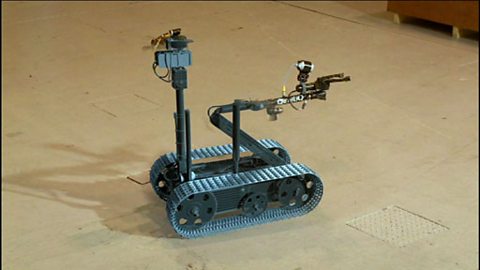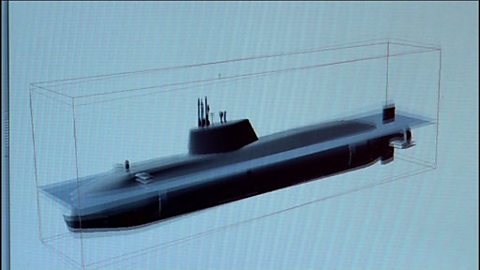JENSEN BUTTON:See you.
NARRATOR:'McLaren, one of the world's leading Formula 1 companies, has been building racing cars for nearly 50 years.
NARRATOR:'They are now entering the competitive world of commercial road cars, with their first ever mass-produced super car, the MP4 12C.
NARRATOR:'The company's hoping special materials that they use on their Formula 1 cars, will give them the edge in the mass-produced car market.
NARRATOR:'Chief mechanic, Neil Trundle, knows the importance of specialist technology.'
NEIL TRUNDLE:This is MP4/1, the first carbon chassis Formula 1 car ever made, this is an old friend of the family.
NARRATOR:'The new road car has its genesis in this Formula 1 car. The first to use a lightweight material in the chassis borrowed from the aerospace industry, carbon fibre.'
NEIL TRUNDLE:Because of this inherently weak area here,
NEIL TRUNDLE:the aluminium chasses were twisting. When we did the carbon chassis, we realised we achieved a 100% stiffer chassis than made before.
NEIL TRUNDLE:So, suddenly, our car was the leading technology. Some of the other teams said that it was a fragile material, that it would shatter, but all the accidents we've had in it proved that it was up to the job.
NEIL TRUNDLE:And since then, carbon chasses have got stronger and stronger, and safer and safer. But this was the start of it.
NARRATOR:'Not only was the company's carbon chassis stronger and safer, but it was a lot lighter, which meant acceleration and handling were greatly improved.
NARRATOR:'And by applying these design features to the new road car, it too is lighter, so faster, and stronger, so safer, improving it's fitness for purpose.'
NARRATOR:'All the new road cars start life like this, a carbon fibre tub.'
ANDY SYLVESTER-THORNE:This is the very first component that goes to making the car.
ANDY SYLVESTER-THORNE:Without the tub, the interior doesn't have anywhere to fit, you can't put the crash structure on, you can't put the engine in, you can't put the body panels on.
ANDY SYLVESTER-THORNE:Everything about this tub is maximised to combine as many functions as possible into a single component.
NARRATOR:'The tub is made away from prying eyes, in a factory in Austria.'
ANDY SYLVESTER-THORNE:What I have here is a biaxial material, which means that on one side you have fibres running that way, and on the other side, you have fibres running that way.
ANDY SYLVESTER-THORNE:And that's held together by the stitching you can see here. Now, by layering this up in different ways, by using the triaxial material and the biaxial material, we can orientate the strength in the direction that we want it, without adding additional weight.
NARRATOR:'Pieces of carbon fibre are layered until they form the correct shape.'
ANDY SYLVESTER-THORNE:This is the part of the process that I'm really excited about. It's where we actually combine the carbon fibre preforms with the resin that will hold the whole lot together' and form of the carbon monoshell.
ANDY SYLVESTER-THORNE:So, we have three different areas of this system. We have the preform loading section, which is what you can see behind me. We have the transfer system, which will then take the tool from this area into the press.'
ANDY SYLVESTER-THORNE:We then have the resin injection system, and that is where all of the clever bits are done.
NARRATOR:'This machine is where a secret process injects a resin into the mould under intense pressure.'
ANDY SYLVESTER-THORNE:Unfortunately, I can't go into too many details, because it is top secret, it's the sensitive area of the tub where we really don't want everyone to understand exactly how we make what is effectively the recipe for the tub.
NARRATOR:'This secret system is completely unique to McLaren, and means a new tub can now be produced about every four hours.'
ANDY SYLVESTER-THORNE:With this process, we've reduced the number of man hours it takes to build the chassis from 4,000 on the F1 road car, down to four hours on the MP4 12C. Makes me really proud.
NARRATOR:'The secret process has brought the production cost down by 90%.
NARRATOR:'Specialist technology like carbon fibre is increasingly being transferred into commercial use, with companies hoping it will give them the edge over their competitors.'
Video summary
What does it take to design a supercar?
Engineers at British Formula One team McLaren show us around their production floor and tell us about the use of carbon fibre in the build of the chassis and tub on their supercar, the MP4-12C.
McLaren use F1 innovations and insights from the aerospace industry to try and gain a competitive edge over companies like Ferrari and Lamborghini in the supercar market.
The engineers tell us about some of the techniques and materials they use.
They explain the benefits of carbon over alluminium and talk us through special materials such as bi-ax.
Modern carbon fibres and a secret process are used to make a stronger and lighter interior monocell tub and the process has been streamlined to mass produce a fast, light, strong commercial road car.
Teacher Notes
Could be used to demonstrate a practical use for composite materials or to show the processes involved in making an engineered product using them.
The class could discuss the advantages and disadvantages of using a composite material for a car body chassis, rather than aluminium.
This should include reference to cost and sustainability issues.
Students could test a range of different non-composite and composite materials and compare their properties.
Students could also research other products that are made from composites, explaining the reasons why they have been used for each example.
This clip will be relevant for teaching Design and Technology, materials.
This topic appears in OCR, Edexcel, AQA, WJEC KS4/GCSE in England and Wales, CCEA GCSE in Northern Ireland and SQA National 4/5 and Higher in Scotland.
How robots are used in risky situations
How robots can be used in work

How satellites survive in space. video
A thermal architect explains how satellites are designed.

Why CAD/CAM is an essential design tool. video
Find out why the Royal Navy use CAD/CAM to simulate design
